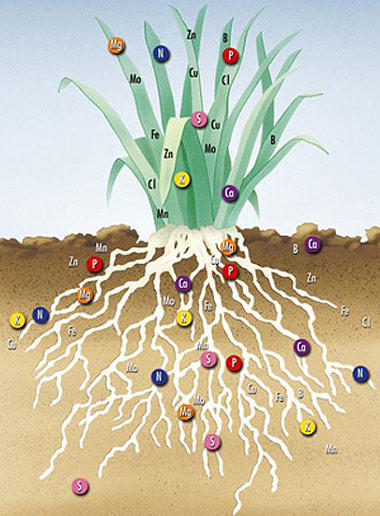FERTILIZER NUTRIENT FUNCTIONS
Fertilizer Nutrient Functions
RESIDENTIAL FERTILIZING
PRIMARY NUTRIENTS
Nitrogen (N)
– Key element in turfgrass nutrition
– Promotes vigorous leaf and stem growth to improve the overall quality of the turf
– Essential component of the chlorophyll molecule which gives turf its dark green color
– Involved in regulating the uptake of other key elements
Phosphorous (P)
– Used in the formation and transfer of energy within the plant
– Influences early root development and growth – Encourages plant establishment
Potassium (K)
– Used by the plant in large quantities, second only to nitrogen
– Key component in the formation of carbohydrates, or food for the plant
– Encourages rooting and wear tolerance
– Enhances drought and cold tolerance
– Key component in cell wall strength and resistance to disease
SECONDARY NUTRIENTS
Calcium (Ca)
– Strongly influences proper soil pH
– Essential to strong cell wall structure and cell division
– Can improve soil structure, water retention and infiltration
Magnesuim (Mg)
– Plays an important role in photosynthesis and chlorophyll production
– A necessary component in many essential enzyme systems within the plant
– Important in aiding the translocation of phosphorous
Sulfur (S)
– Works with nitrogen to produce new protein for plant growth
– Plays an important role in the utilization of oxygen by the plant
– Influences the level of activity of soil microorganisms
MICRONUTRIENTS
Iron (Fe)
– Necessary for the formation of the chlorophyll
– Iron deficiencies are most common in wet, cold, or high pH soils
– Aids in the activation of a number of biochemical processes within the plant
Manganese (Mn)
– Important to the formation of chlorophyll and the activation of the initial growth process
– Generally available in sufficient quantities in the soil
Zinc (Zn)
– Necessary for the production of chlorophyll
Copper (Cu)
– Important in the synthesis of certain plant growth substances
– Serves as an activator for several essential enzymes
– Needed only in small quantites; large amounts can be toxic to turfgrass plants
– Deficiencies are usually only found in highly alkaline (high pH) organic soils or heavily leeched soils
Chlorine (Cl)
– Although essential for proper plant function, only small quantities are required
– May help in the regulation of osmotic pressure within the plant cell
– Deficiency is rarely observed

